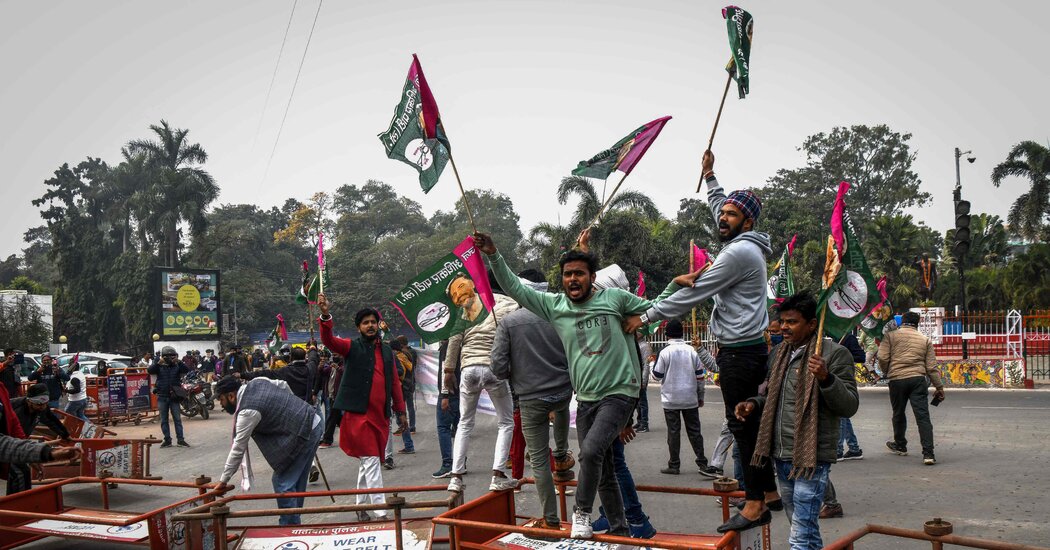NEW DELHI — India’s government on Tuesday unveiled its annual budget, which proposed a significant spending increase for highways, road and airports, but a smaller increase for rural development and employment.
The $530 billion budget for the fiscal year beginning on April 1 put forth by Prime Minister Narendra Modi’s government represented a major investment in infrastructure, but critics said it does too little to address urgent problems the country faces. Among the big ones: rising unemployment, declines in household income and personal spending, and mounting discontent over economic inequality that the pandemic has made more glaring.
The coronavirus has hobbled India’s economy, robbing it of momentum needed to provide jobs for its young and fast-growing work force. It has also worsened longer-term problems that were already dragging down growth, such as high debt, a lack of competitiveness with other countries and policy missteps.
“You have to grow much faster on a sustained basis. That’s what we don’t have,” said Priyanka Kishore, the head of India and Southeast Asia for Oxford Economics, a research firm.
People across the board have seen an erosion of their real incomes, said Sunil Kumar Sinha, the principal economist at India Ratings, a credit ratings agency. “The income growth is not even matching up to the rate of inflation in the economy,” he said.
As a result, many middle-class Indians have put off buying washing machines, large-screen televisions and kitchen appliances, goods they once splurged on during the festival season. Demand is also cooling off in poorer, rural areas, experts say.
The government had estimated that India’s economy would grow 11 percent for the year ending March 2022. It has now revised downward that estimate, to 9.2 percent. The estimate for the coming year is 8 to 8.5 percent.
Those numbers come on the back of a deep contraction of 7.3 percent in the year that ended March 2021, when Mr. Modi imposed a nationwide lockdown to curb the spread of the coronavirus. Hundreds of thousands of people lost their jobs and went back to their villages, trying to eke out a living from meager farm plots.
The government’s ambitious vaccination program helped bring back some momentum, but Mr. Modi’s unwillingness to spend big has held back growth, economists say.
The new budget calls for a 35 percent increase in spending, mainly on infrastructure related projects. The government stressed that the emphasis on construction would expand the economy.
“The approach is driven by seven engines, namely, roads, railways, airports, ports, mass transport, waterways, and logistics infrastructure. All seven engines will pull forward the economy in unison,” said Nirmala Sitharaman, Mr. Modi’s finance minister, while presenting the budget in Parliament.
But the proposal is less generous on rural employment programs, and did not offer something economists have long urged: an urban employment plan to help daily wage laborers in the country’s big cities.
Economists are particularly concerned about the slow rate of job creation, as millions of people are still out of work or have given up their search entirely.
Before the pandemic hit, India was lifting millions of people out of poverty. It took the country decades to have an economy large enough to employ more than 400 million people, said Mahesh Vyas, the chief executive of the Centre for Monitoring Indian Economy. Now, the country has an additional 187 million people that need employment, he said, a tall order in the current circumstances.
The deep scarring to the economy is particularly visible in the statistics for employment and jobs. The center estimated that only about 38 percent of the country’s working-age population was actually employed in 2020. By June of 2021, the number had dropped to 34.6 percent, it said.
“That means people don’t have food on the table,” said Ms. Kishore, of Oxford Economics. “People are not even looking because they are so discouraged.”
The desperation has been spilling out onto the streets just as Mr. Modi and his party face a crucial test in state elections in the coming weeks.
Last week, hundreds of applicants for railway jobs burned train coaches to protest what they said were the Modi government’s unfair recruitment practices. More than 12 million people applied for 35,281 jobs.
“Protests because of the railways jobs is a reflection of frustration among the youth as the government has moved far too slowly, almost dithered in providing the jobs it promised in 2019,” said Mr. Vyas.
A large share of the government’s spending will be raised from borrowing and taxes, including those on fuel and fertilizers, which have contributed to rising price of food and essential commodities. Another major concern for economists is the government’s attempts to keep its deficits in control by reducing the spending on social schemes and welfare.
They have long argued for higher taxes on corporations and the country’s rich to enable the government to spend more in such areas, a demand that wasn’t addressed in the budget.
The spending plan must be passed by the Parliament before it comes into effect in April.
Dr. Sinha said that the government’s focus on infrastructure spending may bring gains in the medium- to long-term, but one of the most important pieces that’s missing from the budget is a comprehensive plan to bring back consumption.
“The problem with this kind of spending is that it will have a fair amount of gestation period,” he said. “But the challenge that the economy is facing at the current moment is that household sentiments, household incomes, everything is under pressure.”
“Something needs to be done to put money in the pockets,” he said.


























